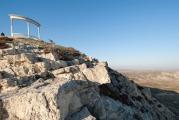Ubein wooden bridge, Myanmar. Ubein Wooden Bridge, Myanmar Construction of the Ghoteik Bridge
Myanmar, a country located in South-East Asia, on the Indochina Peninsula, is not yet as popular among tourists as, for example, Thailand or Hong Kong. But even in this relatively small state there are a number of attractions that certainly deserve the attention of travelers.
The Ubein Bridge - at the same time the oldest and longest wooden bridge on the planet - of course, is one of those unique objects that is simply impossible not to visit. The exact date of construction of the Ubein Bridge is unknown. Scientists call the year 1850, and the bridge was built in just one year.
During construction, durable teak wood was used, which was left over from the former royal palace in Ava. The total length of the Ubein Bridge is 1.2 kilometers. It consists of two parts that connect at an angle. This pedestrian bridge connects a small village with the city of Amarapura and crosses the waters of Lake Tauntome.
To visit Ubein Bridge, you should go to Mandalay District, in central Myanmar. The bridge has always been of great importance for local residents, since during the rainy season they simply have no other opportunity to cross the lake. Today the Ubein Bridge is also important tourist site, which brings considerable profit to the local population, which actively offers travelers various souvenirs.
Tourists love to sit in one of the covered verandas with benches, from where they can see beautiful view to the surrounding area. There are nine passages for boats under the bridge. Eight policemen guard the bridge, so the safety of tourists is guaranteed.
Despite the fact that teak wood is particularly durable, individual logs from the 1,086 pillars on which the Ubein Bridge rests have already had to be replaced with concrete ones. General impression This did not detract at all from the ancient, solid and very beautiful structure.
Ubein Bridge - PHOTO











Goteik Viaduct is one of the most famous engineering structures in Myanmar (formerly Burma). It was built during the reign of colonial England and in 1900 was recognized as the largest railway trestle in the world. To this day, Goteyk remains the most high bridge in Myanmar.
The viaduct is built in the heart of the country, about 100 km northeast of the largest city of Mandalay, it connects Pyin-u-Lwin (the summer residence of the British colonial administrators of Burma) and Lashio ( The largest city northern Shan State). The railway bridge was built so that Britain could expand its sphere of influence in the region. The entire structure was manufactured at a Pennsylvania steel mill.
Construction of the bridge began in 1899 and ended in 1900, and at that time it was recognized as the largest railway bridge in the world.
The size of the viaduct is impressive: the 689-meter bridge is supported by 15 pillars. The height of Goteyka is 102 m. Despite the fact that many reinforced concrete bridges appeared in the world both before and after its construction, only Canadians managed to “outdo” the Asian giant. In Alberta they built the Lethbridge Viaduct, equal in height to the Goteiku but twice as long. Equal in size to the Burmese miracle are the Joso (Washington), Poughkeepsie (New York) and Kinzua (Pennsylvania) bridges. 
Today Goteyk is famous among tourists all over the world, because taking a train ride over the abyss is a pleasure for real daredevils. The train travels extremely slowly so as not to shake the century-old bridge, which today is not in the best condition. Traveling along the viaduct takes about 25 minutes, during which time everyone has time to enjoy the picturesque scenery and take some wonderful photos.
The sight of such an attraction quickens the heartbeat and takes the breath away for many of us, however, knowing the Buddhist tranquility of the people of Myanmar, one should not be surprised at the popularity of walks along the viaduct.

Amarapura itself was once the capital, like other satellite cities of Mandalay. And now it is a suburb in which there are not even hotels for foreigners, since everyone who wants to look at the bridge comes here in the late afternoon, just before sunset. And we arrived too.
U Bein Bridge(Myanmar residents pronounce U-Pain) is the longest and oldest wooden (teak) bridge in the world. Its length is an impressive 1208 meters. The Ubein Bridge was built in 1849 and connects the two shores of Lake Tauntome. The piles for the U Bein bridge (of which there are 1,086 pieces) were taken from material left over from the dismantling of the royal palace in the city and moved to the lake. Thus, the teak tree acquired a third life.
By the way, the famous Ubein Bridge is a unique landmark of Myanmar that cannot be compared with any other attraction in the whole world. Just like the rock in Sri Lanka is unlike any other place on Earth.
Interesting fact: Ubein Bridge is not mentioned in the Guinness Book of Records as the world's longest wooden bridge pedestrian bridge for political reasons. Instead, the Horai Bridge from Japan is indicated, despite the fact that it is half as long as the U-Bein Bridge.

There are 3 simple ways get to Ubein Bridge from Mandalay:
- Method 1. The easiest and most inexpensive way to see the Ubein Bridge is to take a minibus from Mandalay that goes to Amarapura. It's worth the journey 500 kyat. You need to catch these small buses at the intersection of 84th and 29th streets. And say that you are going to the bridge so that they drop you off closer. About two and a half kilometers away. And then just ask where to go. Or arm yourself with an electronic card and act independently. If you ask the locals, everyone knows that the foreigners are here for the sake of the bridge, so they will help. You will have to get back to the road to Mandalay and wait there for a passing bus. Or, right at the exit from the bridge, hire a motorcycle taxi for 5000 kyat or a car for 10000 kyat.
- Method 2. There is one more option. Also, a visit to the U Bein Bridge is included in a tour of the three (sometimes four) ancient kingdoms of Mandalay. If you choose this method, then in addition to the bridge you will be taken to Sagaing, Yinwa and to. But it’s worth knowing that, despite the fact that the problem with transport has been solved, there is still time to get acquainted with four different cities won't be enough. Moreover, such an excursion also involves a visit to a weaving factory. A day tour like this would be worth it 45-55 thousand kyat, that is from 40 to 50 dollars, and the tour involves various additional expenses, which will be very difficult to refuse.
- Method 3. If you don’t need other cities and attractions, but just want to get out of Mandalay only for sunset to the Ubein Bridge, then such a tour will be worth it 17,000 kyat (15$).
How to get to Ubain Bridge from Sagaing:
- From Sagaing to Amarapura, where the Ubein Bridge is located, it is a very short drive. You just need to cross the bridge over the Ayeyarwaddy River and drive a little further along the road. The cost of such a trip will be only 5-7 thousand kyat on a tuktuk or 3-4 thousand per person.
- Finding transport to the U Bein Bridge is quite easy. You can stop any tuktuk or car going to Mandalay. For a small fee they will give you a lift without any problems.
U Bein Bridge on the map
U Bein Bridge on the map located in Amarapura near Sagaing, close to Mandalay and its main attractions.
Open on a large Google map →
Legend on the map:
- Brown marker - Ubein Bridge
- Yellow markers - temples near U Bein Bridge
- Blue markers - location of Sagaing and Mandalay relative to Ubain
Amarapura
Amapapura- the same small town in Myanmar as . However, Sagaing is a nice town, while Amarapura is dirty and not very pleasant. And on this moment does not at all live up to its name - “city of immortality”.
The city of Amarapura was founded by King Bodopai in the 18th century as the new capital of Burma, but his son moved his residence to the neighboring one, which was the former capital. For some time, Amarapura was the main city under King Mindon. But he also decided that it was necessary to found new town around .
However, the city of Amarapura is also famous for the fact that there are many weaving factories here, and you can buy silk and cotton products. You can go there on a tour and, of course, buy something. Weaving looms work here behind almost every wall, and when you walk around the city, you can clearly hear their discordant chorus.
There are also several pagodas and monasteries in Amarapura (including one on the other side of the lake), but we did not visit any of these places during our visit. Like many others, we were primarily interested in the U Bein Bridge. Let's talk about it further.

Ubein teak bridge in Myanmar
U Bein Wooden Bridge - Historical Monument
Wooden bridge U-Bein in Myanmar is the world's oldest teak stilt bridge. It was built in Amarapura almost 170 years ago. Teak wood is a very strong material and is renowned for its durability. For example, on the island of Java in Indonesia, hundred-year-old teak houses are known to withstand the humid climate of Asia and do not rot, and teak oil repels harmful insects.
But a tree cannot live forever, especially if it has already been cut down. Now only a small part of the original bridge remains. Basically, these are logs standing vertically that support the bridge. Unfortunately, the logs rot and are gradually being replaced with concrete piles. So the further you go, the less original there will be in the U Bein Bridge. But for now it really makes an impression and is worth a visit to Amarapura for its sake.
We have seen a wide variety of teak buildings and structures in Asia, such as the huge teak houses in and the temple in Khun Yuam in, but the U Bein Bridge in Myanmar seemed the most grandiose among them all. Teak is actually a wonderful material for construction.


But the people of Myanmar love him very much

The Ubein Bridge is still alive, and not just a tourist attraction. It sways a little from side to side and creaks as if it is complaining. It is used every day not only by foreigners, but also by local residents, of whom there are quite a lot here. They live under the bridge and nearby, they fish, their children play. They live, of course, very poorly, simply in squalid conditions. But this is the reality.
Now that tourists are interested in the bridge, local residents have the opportunity to earn money. They sell everything. A fortuneteller sits in one of the gazebos on the bridge. Although, as it seemed to me, only Burmese who believe in astrology go to him, just as we believe in Newton’s laws.
Impromptu cafes have been set up on the islands at the foot of the bridge. Well, you also come across all sorts of charlatans, where would you be without them in such a popular tourist place. That's why there are as many as 8 policemen on duty at the U Bein Bridge!


An improvised amphitheater for tourists awaits its sunset hour on the shore of the lake right under the Ubein Bridge
Watching life near the bridge is very interesting, although sad. A real drama broke out right before our eyes when a duck breeder came to sort things out with the boatmen over a dead duck. He was very upset and threatened them with a machete, while his wife ran after him and tried to calm him down. Luckily, it cooled down quickly and no one else was hurt.
But the main thing is that we, tourists, will come and go, but people will remain here and will go about their business across the lake along the U Bein Bridge for many years to come.


They live in huts like these and are engaged in duck breeding and fishing in Amarapura




Photo of Ubein Bridge at sunset
As I already said, the Ubein Bridge is most popular among tourists in the pre-sunset hours. At this time, hundreds of tourists (mostly from Mandalay) come to Amarapura, armed with photographic equipment of various calibers. A cafe opens for them on the shore of Lake Tauntome, where they can drink a cocktail and have a small snack while enjoying best view to U Bein Bridge.
However, the most The best way to see the Ubein Bridge in sunny weather is to hire one of the hundreds of boats from the boatmen standing along the lake waiting for clients. It costs about 15-20 dollars, depending on the number of people in the boat. The boatman will take you to the best point on the lake, the best place to take photos of the U Bein Bridge at sunset, when the red sun drops beautifully towards the horizon.
We decided not to waste time on a boat ride, but to walk across the bridge and do beautiful pictures Ubein from different points, including from the island, which can be reached by stairs.









RoomGuru. He immediately looks for best deals on the Internet and shows the most profitable ones. All that remains is to choose the right one and go on vacation!
Goteik viaduct is one of the most amazing and interesting engineering structures in Myanmar(formerly Burma). Located in the western Shan State, about 100 kilometers northeast of the city of Mandalay, it is the tallest structure in the country and at one time considered the largest railway overpass in the world, it is now a favorite tourist destination.


Construction of a viaduct Goteyk It was started in 1899 and completed in 1900, during the time of colonial England and then it was recognized as the largest railway trestle in the world. The bridge is 689 meters long and connects Pyin-u-Lwin (the summer residence of the British colonial administrators of Burma) and Lashio (the largest city in northern Shan State).




The height of Goteyka is 102 meters and it is supported by 15 pillars. The entire structure was manufactured at a Pennsylvania steel mill. During this time, many railway bridges appeared, but only a few could even match its size. "Outperform" Goteyk Viaduct Only the Lethbridge viaduct, located in the province of Alberta (Canada), was able to do so, which does not exceed it in height, but is twice as long. There are also similar sized bridges: Joso viaduct in Washington, Poughkeepsie in New York and Kinzua in Pennsylvania.




Now Goteyk Viaduct is a local landmark Myanmar (Burma), which, although it wobbles quite noticeably every time a train passes, still works. After all, riding a train over the abyss is a great pleasure, it’s like you’re riding on a roller coaster, and it’s simply breathtaking!




Directions by Goteik Viaduct takes about 25 minutes and the train, in order not to shake the centuries-old structure, the train travels quite slowly and thanks to this you can enjoy the trip to the fullest, while taking wonderful pictures, because even the landscape outside the train window at such a height looks different.




